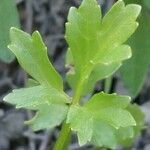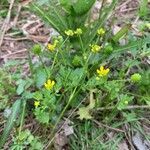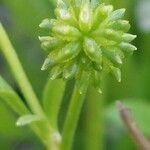Stems erect or reclining, hispid or sometimes glabrous. Basal and lower cauline leaf blades cordate-ovate, 3-foliolate, 5-8 × 3-6(-7) cm, leaflets again cleft or parted, leaflet base obtuse to acute, margins dentate, apex rounded to acute. Flowers pedicellate; receptacle hispid; sepals 5, reflexed, 3-4 × 2 mm, sparsely hispid; petals 5, 4-5 × 2-3 mm. Heads of achenes ovoid, 8-9 × 6-7 mm; achenes 30-60 per head, 2 × 2 mm, faces densely tuberculate, glabrous, margin smooth; beak semicircular, hooked, 0.3 mm.



